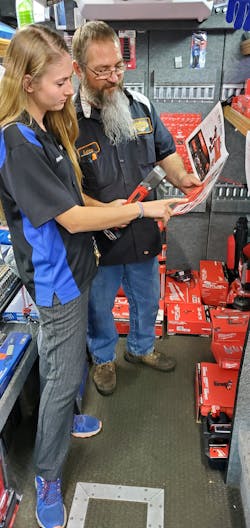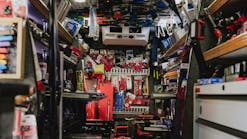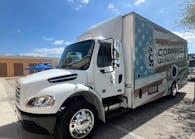The performance gap between pneumatic tools and cordless tools is growing thinner and thinner. In today’s shops, more technicians are gravitating towards cordless– not just for convenience, but for power output, technology advancements, and versatility.
Technicians of years past widely accepted that, in most cases, pneumatic tools offered more power. But that’s no longer the case. With very few exceptions, any job that can be done today with a pneumatic tool can be done with a cordless tool. As system components continue to advance, technicians are picking up cordless ratchets, drills, and grinders to help complete additional tasks in and around the shop. Learn what advanced features come standard on these products, what features could become the next set of standards, as well as tips for selling cordless tools to help drive more sales.
Setting the standard
As with most products, wait a bit and you’ll find that newer and more efficient versions emerge with time. For cordless tools, the battery and the motor are two major components that have undergone significant enhancements over the past decade, resulting in the new standards found in cordless tools today.
Gone are the days of nickel-cadmium (NiCd) batteries. Lithium-ion (Li-ion) batteries now take center stage as the standard for cordless tools.
“It’s now hard to find any sort of cordless product sold that wouldn’t have a lithium-ion battery,” says Mark Kelly, manager of product marketing at Milwaukee Tool. “If you’re not buying a lithium-ion battery, you’re behind on times.”
Although the Li-ion battery is not new in the automotive industry, manufacturers have recently begun to incorporate 21700 Li-ion battery cells within cordless tools. Developed by Tesla Motors and Panasonic, the 21700 battery cells offer more energy density and a therefore a longer run-time than the current 18650 Li-ion battery cells.
Milwaukee Tool uses 21700 battery cells in their M18 High Output system and more recently in their M12 High Output system.
“With 21700 cells you have a lot more power that you can get out of the products, and more run-time, because they are a little bigger and longer [in size],” Kelly says. “Even though it’s still lithium, the technology is continually [evolving] and we’re continuing to bring that new technology to the market.”
The 21700 battery cells in Milwaukee Tool’s High Output batteries are the same cells that Tesla uses in their cars, says Kelly. “They just use a lot more batteries and more cells, but it’s the same technology,” he adds.
When it comes to the motor found within cordless tools, the standard is becoming brushless.
With a brushless motor, tools require less maintenance, offer more power, and have a longer runtime. That is because a brushed motor creates friction, which results in reduced speed and heat buildup. A brushed motor also takes more energy to maintain its speed and the brushes wear out over time.
In a brushless motor, there are no brushes and therefore no friction, allowing the motor to run cooler and work more efficiently.
“[Brushless] is what the users want and are requesting,” says Matt Rivera, automotive national account manager at Makita. “There are still products out there – we still make products – that have brushed motors, but it seems to be that the market is going to brushless.”
Brushless motors offer many performance benefits, as well as a more compact size.
“Brushless technology allows us to shrink down the motor and [yet] allows that motor to be efficient,” says Lauren Chell, group product manager at Mac Tools. “So essentially, you’re getting either the same amount of power or sometimes even more power in a smaller package.”
The next generation of industry standards
With the advancements in technology growing at an exponential rate, there are many features in the market today with the potential of becoming the next industry standard.
“You’re starting to see Bluetooth technology incorporated,” Makita’s Rivera says. “That’s something that is going to expand and take off.”
For Milwaukee Tool, Bluetooth connectivity is already becoming standard in their cordless tools with ONE-KEY, a platform that provides inventory management, security, and smart tool solutions.
“We’re going to have a lot of tools coming out that will have ONE-KEY pretty much standard,” Milwaukee Tool’s Kelly says. “With [ONE-KEY] connectivity, we’ll have the ability to adjust products more than we have in the past so that users can control more aspects of the tool.”
Tool setting controls is another feature growing within the industry. Whether via Bluetooth or built-in, putting more control in the user’s hand is becoming a sought-after design feature for many tool manufacturers.
One example of this can be seen with Ingersoll Rand’s latest impact wrenches (W7152, W7172, W5133, and W5153). All have a built-in power regulator that allows users to select from four fastening modes: full power, half power, wrench tight, and hand tight.
Similarly, Milwaukee Tool features Lug Nut Mode that is enabled through the ONE-KEY app that prevents the over-fastening of lug nuts by automatically shutting off the tool.
Today’s cordless products aim for task unification, meaning multiple features can be used at the same time. A good example of this is built-in lighting while a tool is in motion.
“Our W7152 Impact Wrench has a bright, 360-degree shadowless task LED on the front that illuminates the work surface, while [the wrench] also performs its fastening jobs. Previously one might [have needed to] arrange a light in an awkward position to illuminate the surface where they are trying to work,” says Hunter Golden, global product manager of industrial tools at Ingersoll Rand. “With a cordless tool you’re able to combine that into a single job.”
Tips on selling
Amelia Klenoski is a Cornwell Tools dealer with a route located in Battle Creek, Michigan. She has been selling tools from a truck for just over two years, mostly to independents and dealerships with a few heavy duty shops along the way.
Klenoski says most of her customers prefer cordless tools over pneumatic and that the only time they would even consider an air tool is for their smaller size.
Her best-selling cordless tools are ratchets, including 1/4”, 3/8”, and 1/2” sizes, but also impact wrenches and grease guns. Cordless ratchets are more ideal for technicians for working inside the vehicle without having to worry about dragging a dirty air hose in the vehicle, she notes.
“I [also] sell a lot of Milwaukee Tool 1/2” impact wrenches because the torque is just about the same, if not more, than pneumatic impact wrenches and you don’t need an air hose,” she says. “A lot of road guys and tow truck drivers also like them because they are much easier.”
Having a display of demo tools on the truck has been a tremendous selling opportunity for Klenoski. The open display allows technicians to not only pick up the tool, but also lets them try it out.
“Many technicians might say, ‘Well this isn’t going to take a lug nut off,’ so I tell them to go ahead and try it out,” Klenoski says. She lets the technicians take the tool into their shop and put it to work.
When a technician is looking to buy a cordless tool, Klenoski says it’s best to first ask what application it is for and go from there. She recommends asking questions such as: Will it be for suspension work? Is it for removing lug nuts? What’s the torque on the bolt you need to remove?
It’s also very important for tool dealers to know and understand the specs of the tools to make the sale. The most common feature for cordless tools, according to Klenoski, is torque. Many tool manufacturers offer different options for torque (high-torque, mid torque, etc.) and different settings which allow technicians to adjust as needed.
However, Klenoski finds that “most guys will go for the biggest [torque rating] just because,” she laughs.
The momentum continues
These products’ popularity is apparent just by walking through a shop and seeing the number of cordless tools used by technicians today. In addition, many tool manufacturers are experiencing an increase in sales.
“It’s been crazy – the growth [in cordless tools],” Milwaukee Tool’s Kelly says. “It’s our fastest growing business segment I think for the entire company.”
Makita’s Rivera agrees that they have seen an increase in cordless tool sales in automotive as well. They have also seen an increase in their outdoor power equipment (OPE) in connection with their automotive sales.
“It doesn’t seem like it would make sense in automotive, but what we have learned is that OPE like blowers are [used by] detailers,” Rivera says. “They use the blowers to blow off the water spots on vehicles. It’s like [equipment] is expanding because users are finding more uses for cordless.”
The flexibility with technology alone is not the only driving force behind the growth in cordless tool sales. Convenience and versatility are still main selling factors as well. When it comes to selling cordless tools, understanding the specs needed for the job at-hand and potential jobs down the road, can help in recommending the right product for the job.
In the end, whether for technology advancements, versatility, power output, or convenience, cordless tools continue to gain momentum in shops. With many to choose from, staying acquainted with the industry trends and features will be key in making the sale.



